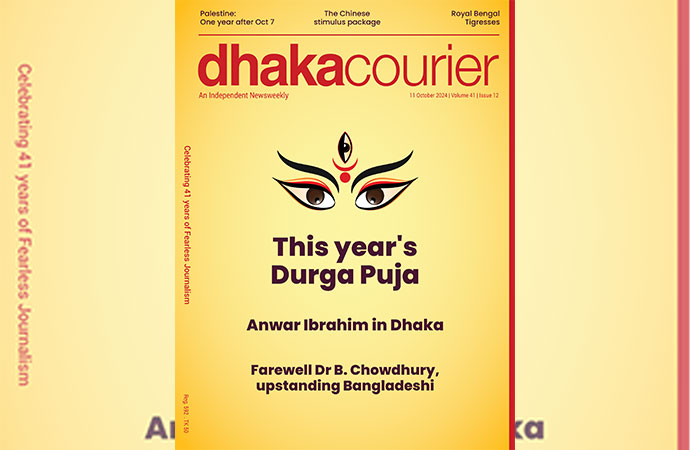Nature

Graceful flight of the red-crested pochard. Photo: Enam Ul Haque
The bedecked duck certainly brightened our morning and colourfully inaugurated our birdwatching tour of the Haor Basin on the first week of the New Year
A red-billed duck landed with a splash on the shallow water near us as we stood at the bank of Bagmara, a trivial beel of Tanguar haor. The duck was an adult male red-crested pochard with its orange crest half-raised and the dark-chocolate neck strained, whether in distress or exuberance, we could not tell.
The bedecked duck certainly brightened our morning and colourfully inaugurated our birdwatching tour of the Haor Basin on the first week of the New Year. That elegantly costumed bird was the prettiest bird of the haor, if not of all the waters we annually visit to count the waterfowls.
The red-crested bird was, however, not too happy to come so close to a bunch of binocular-bearing bipeds. With its round red eyes, it looked at us warily for a few moments, then silently but swiftly swam as far away from us as it could without bumping into the feeding territory of other ducks.
The close encounter of that single wild bird for those few blissful moments lifted our spirit; it just felt like a moving experience of our lives. We suddenly knew why in his poem the great nature-lover Ted Hughes wrote:
The wild duck...
Got up out of the ooze before dawn
Now hangs her whispering arrival
Between earth-glitter and heaven-glitter
For that red-crested bird, as for all wild ducks arriving at Tanguar haor, the crack of dawn was but a time of trouble-free feeding. The lone red-crested guy soon joined the friendly crowd of other red-crests feeding on the exposed aquatic plants of the fast-drying Bagmara beel.
The red-crested pochards are gregarious ducks and can feed and float in loosely packed crowds of hundreds of individuals without engaging in serious quarrels. Fighting over food is pointless; there is no shortage of the vegetables the ducks love to take for breakfast, lunch and afternoon snacks.
We were delighted to see a sizable number of those beautiful pochards feeding at Bagmara Beel at dawn. Their number grew faster as we counted them in five other beels of Tanguar Haor. The population of these vegetarians, fortunately, has not been falling as fast as the other ducks in recent years.
It was a pleasure to see the long lines of rusty-red heads, bright red bills and the round red eyes of the male red-crested pochards everywhere in Tanguar Haor. The females, of course, were there but not at all keen to take the spotlight away from the showy males.
The female red-crested pochard is not as loudly attired as the male. The female wears a simple buff dress, a brown cap, black eyes and only the slightest touch of red at the tip of its dark bill. While quite distinctive by herself, the female is not very noticeable in the crowd of colourful males.
By pointing out the 'red crest' the English name of the bird actually described its male, not the female of the species. The female has no crest and no prominent red plumage. Unfortunately, this discourteous chauvinism pervades the naming of most birds in most languages.
Red-crested pochards pass the short winter days mostly by feeding and snoozing on the tranquil water of Tanguar Haor. Sometimes a few romantic males take their time off from feeding to swim along with the females in an attempt to form early pair-bonds.
Some excitement and occasional commotion are not uncommon among the romantic pairs of red-crested pochards. There would be some raising of red crests, showing of red eyes and short pursuits when a male blunders into the territory of another male courting a female.
We do not know how many of the early pair-bonds formed on the quiet waters of Tanguar Haor survive through the long migration to the breeding ground. Red-crested pochards are known to breed in Mongolia, Central Asia and Southern Europe.
Where do the red-crested pochards wintering in Bangladesh breed - Mongolia or Central Asia? That secret remains hidden in the deep dark eyes of females and the round red eyes of males. We have yet to fix a few tiny transmitters on them to find out that secret.
We know that the extensive green garden under the water of Tanguar Haor can feed thousands of red-crested pochards well enough to keep their population from dwindling. They would thrive as long as the Haor and the wetlands of their breeding ground remain productive and free of predation.
We do not, however, know how long Tanguar Haor will continue to be a good winter home for the red-crested pochards and other wild ducks. We have witnessed an ever increasing number of domestic ducks brought in the haor by a large number of commercial duck farms every winter.
Thousands of domestic ducks have been depleting the food sources on which survival of the wild ducks depends. Moreover, the free mixing of the wild and domestic stocks at such a large scale greatly raises the risk of transmission of bird flu from one to the other.
Tanguar Haor was once a major wintering home of a few hundred Baers' Pochards of which not one winters there anymore. The number of common pochard there has also nose-dived from several thousand to a number you could count on fingers.
Could one day the elegant red-crested pochards of Tanguar Haor go the way other pochards went?
Enam Ul Haque is the Chairman of WildTeam.
From The Business Standard

























Leave a Comment
Recent Posts
FIFA President to Join Youth F ...
FIFA President Gianni Infantino has said he will join the youth festiv ...
Chief Adviser Yunus engages wi ...
Chief Adviser Prof Muhammad Yunus on Tuesday had brief interactions se ...
Chinese investors interested in Bangladesh’s power, ..
Dr Yunus expands Council of Advisers with 3 new face ..
Bangladesh receives $655 million in remittances in 9 ..
COP29: Chief Adviser Yunus scheduled to leave for Az ..